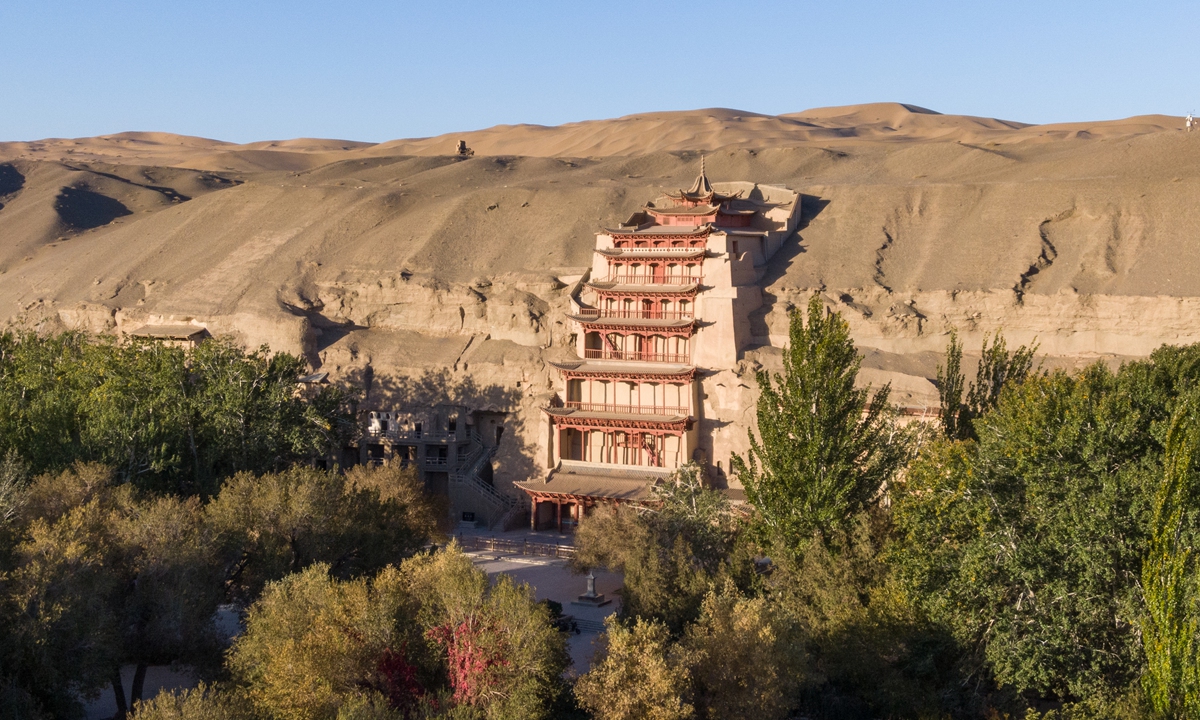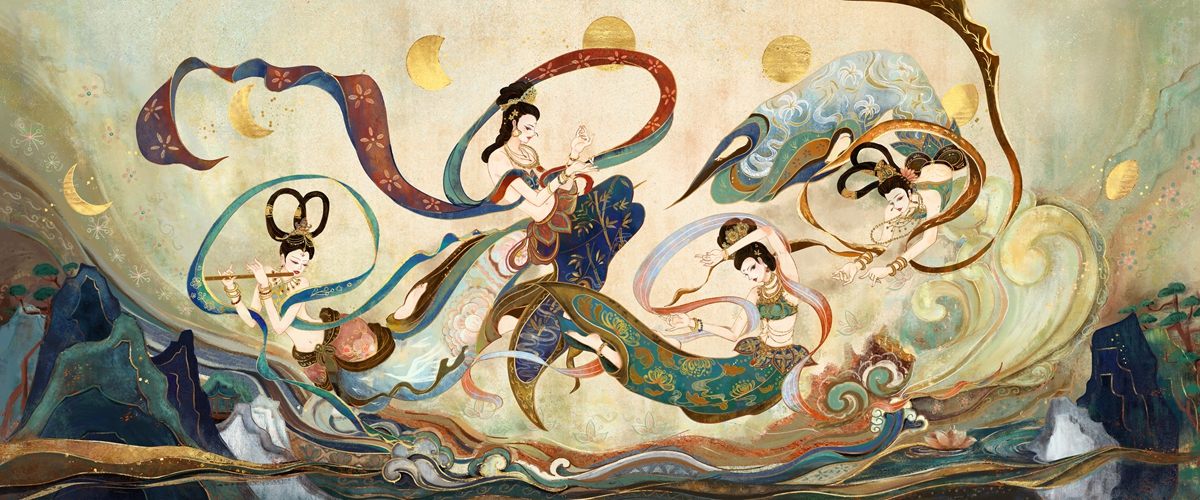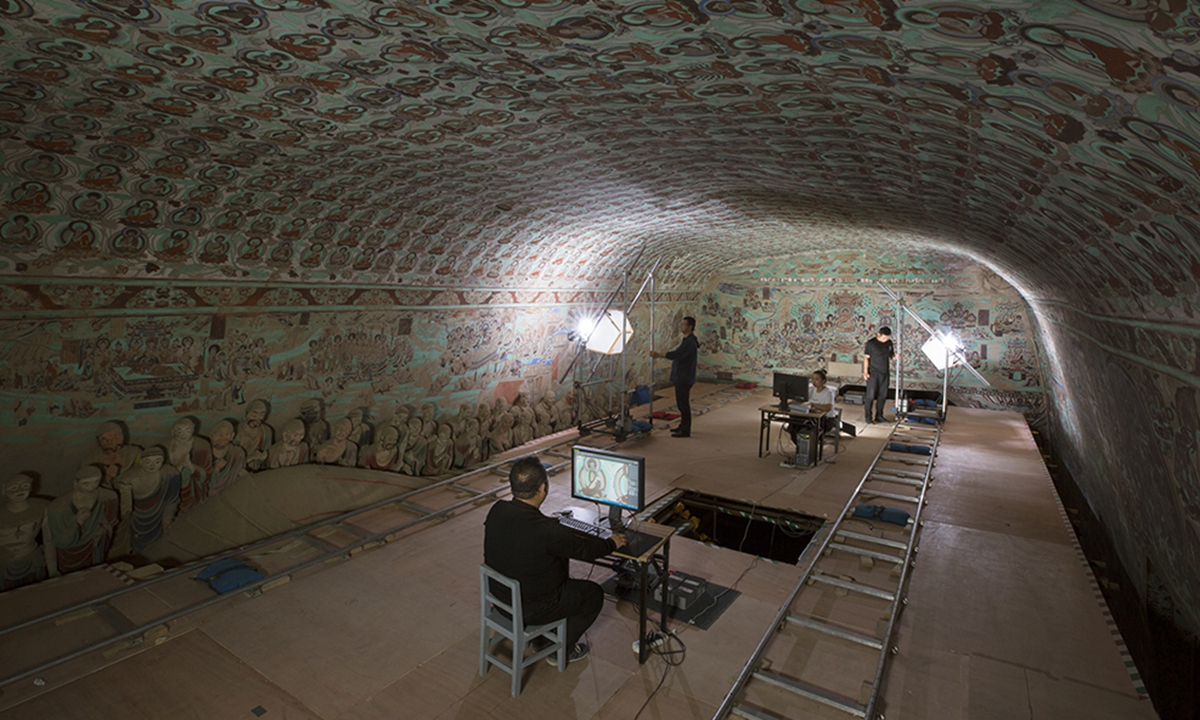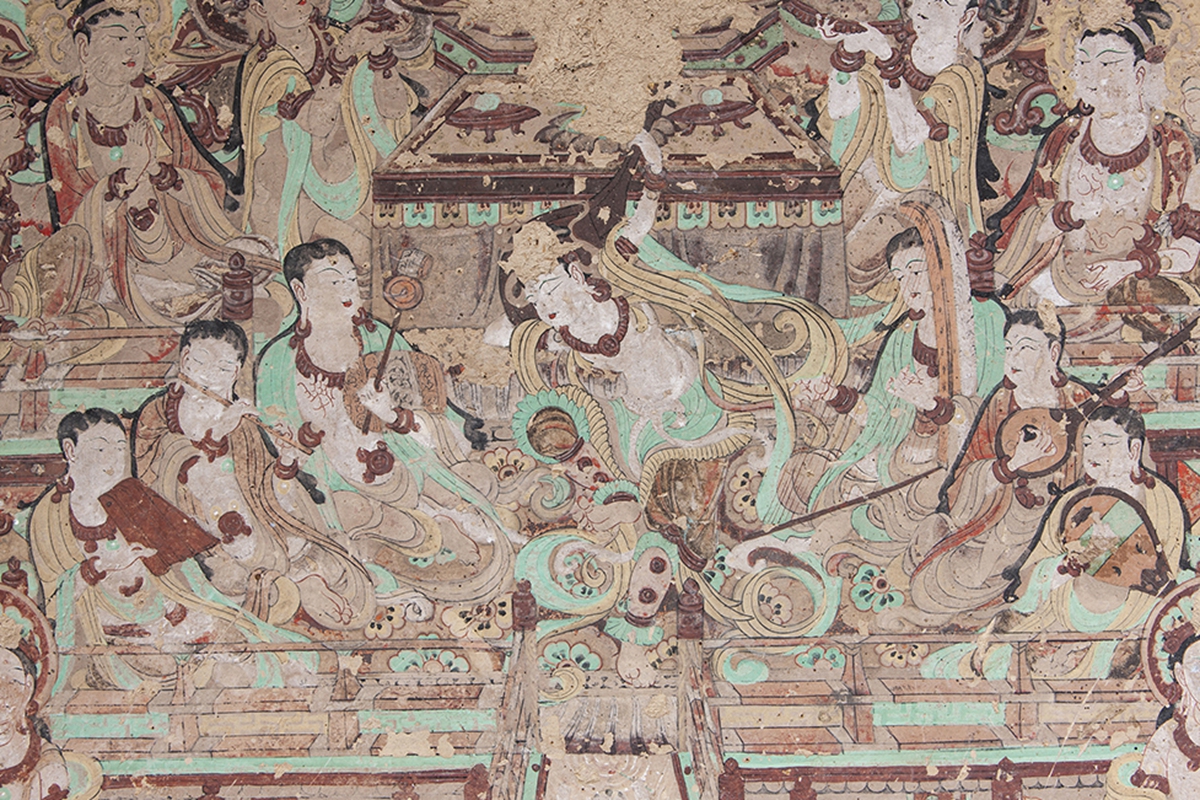
The Mogao Caves in Dunhuang, Gansu Province Photo: Courtesy of the Dunhuang Academy
A Mogao Cave mural shows flying apsaras. Photo: VCG
In the Mogao Cave 335 in Dunhuang, ancient yet still exquisite murals record the joyous celebration of musical bodhisattva playing the instruments. However, there are obvious traces of four places where the murals were peeled off, which shocked many tourists.
The tour guide standing by explained that these were taken by the American "art historian" Langdon Warner who used a special chemical solution to peel the frescoes from the cave walls in the 1920s. Currently, these murals are collected by Harvard Art Museums in the US. After the explanation, the curious gazes of the tourists in the small cave suddenly dimmed, and they all stopped to sigh.
The Mogao Caves in Dunhuang, a cave temple that has gone through thousands of years, stand as a millennium-old testament to the splendor of ancient Chinese civilization. However, after the hidden scriptures being discovered in 1900, most of the scriptures were plundered by so-called Western "archaeologists" and "explorers."
According to incomplete statistics, in the cave with a length and width of more than 2 meters and a height of about 3 meters, a total of more than 60,000 cultural relics such as Dunhuang manuscripts, silk paintings, and Buddhist instruments were unearthed. The rich treasures make the cave of scriptures one of the most important archaeological discoveries of the 20th century. But most of these cultural relics have been lost to more than 30 public and private collection institutions in more than 10 countries such as the UK, the US and Japan. These Dunhuang cultural relics that have been lost overseas have not yet returned to their motherland, but they have also made the world know the Mogao Caves in Dunhuang.
Fan Jinshi, the honorary president of Dunhuang Academy, who attended the recent forum in Dunhuang, once summarized the unearthed documents from the Mogao Caves, which are unique, precious materials. These materials cover an "unusually wide range of aspects and are infinitely rich in content," representing the original records of ancient social culture, reflecting the true face of ancient society in many aspects, and are truly cultural treasures.
The Mogao Caves have been inscribed into the world heritage site list in 1987. The UNESCO commented the caves are of "unmatched historical value." As evidence of the evolution of Buddhist art in the northwest region of China, these works provide an abundance of vivid materials depicting various aspects of ancient politics, economics, culture, arts, religion, ethnic relations, and daily dress in western China.
Shahbaz Khan, director and representative of the UNESCO Regional Office for East Asia, said at the forum that the Mogao Caves stand as enduring symbols of a collective heritage as they provide outstanding evidence of the harmonious synthesis of the secular and religious era in ancient China.
Guan Qiang, deputy head of the National Cultural Heritage Administration, also noted at the event that the Mogao Caves not only vividly display the process of sinicization of Buddhism but also powerfully witness the five prominent features of Chinese civilization - continuity, originality, uniformity, inclusivity and peaceful nature.
Strong support of high tech
After visiting about eight caves of the heritage sites from different dynasties, many visitors both from China and abroad are amazed that those murals can still be enjoyed thousands of years later. It is those precious murals which are 1,000-year tapestry of Buddhist art from the caves that help the archaeologists to decode the mystery of ancient Silk Road and its religious, cultural and intellectual influences.
Experts attending the forum said the sustainable protection of Mogao Caves is mainly thanks for the strong support of high tech and multiple disciplines.
Feng Wei, director of the Key Research Base of the State Administration of Cultural Heritage for the Surface Monitoring and Analysis of Cultural Heritages, told the Global Times that preventive conservation is an advanced protection scheme that is widely recognized and constantly pursued by the worldwide conservation community of cultural heritages.
He explained that the mechanism of preventive conservation is to detect changes in the condition of cultural relics and then use AI to immediately analyze the causes of these changes. These technologies don't directly affect the relics themselves but address the external factors causing the changes. If the external factors can be stabilized, the process of deterioration can be halted or slowed, thus protecting the artifacts.
"AI plays a crucial role here by calculating the relative positions at each step using computer vision and AI methods. It is a progressive process; each step may not be perfectly accurate, but theoretically, it gets more precise over time until it is accurate," he said.
Liu Hanlong, an academician at the Chinese Academy of Engineering and expert in environmental geomechanics and disaster prevention engineering, told the Global Times that the emerging microbial geotechnical engineering is a new cross-disciplinary subject and the technology has significant effects on improving the strength, permeability, and other basic properties of the soil body.

A mural in the Mogao Caves Photo: Courtesy of the Dunhuang Academy
Currently, his team is using an active biological mud adhesion repair technology centered around microbial reinforcement techniques to address issues such as cracks, seepage, weathering, and flaking in some cave sites.
Over the years, the Dunhuang Academy has continued to explore various modes of cultural protection and promotion, taking advantage of the "Digital Dunhuang" project that was put forward in the late 1980s.
Su Bomin, dean of Dunhuang Academy, said at the forum that after extensive exploration, the Dunhuang Academy has developed a set of digital workflows and key technologies for immovable cultural heritage.
To date, the digital preservation team has completed the digital collection of murals in 295 caves of the Mogao Caves, image stitching and processing for 186 caves, three-dimensional reconstruction of seven large heritage sites and 45 painted sculptures, as well as the three-dimensional laser scanning of the spatial structure of 212 caves, according to Su.
Digital preservation experts collect digital data on the murals at the Mogao Caves. Photo: Courtesy of the Dunhuang Academy
Share Chinese experience overseas
With such a solid support of protection methods and team, the Mogao Caves in Dunhuang has set a valuable benchmark for global heritage conservation, many experts said at the forum. Many delegations from different countries express their strong willingness to carry out more cooperation with the Dunhuang Academy.
Ajay Kulkarni, an Indian professor of architecture, told the Global Times that the Chinese work in cultural relics protection is very much "in depth, more advanced and more committed."
After listening to the reports by some Chinese archaeologists, he was surprised to find many similarities between some of the cave sites in China and those in India. He could see how Buddhism gradually became sinicized after entering ancient China, which he found quite fascinating.
Sovanlylin Meng, architect of Department of Conservation and Archaeology of APSARA National Authority, Siem Reap Province, Cambodia, told the Global Times that she got a deep understanding about the management and conservation of cave temple sites after participating in the event.
During the event, China and Cambodia signed a Memorandum of Understanding (MOU) in the protection of cultural relics, including co-develop cultural relics conservation programs, share advanced conservation theories and technologies, co-organize international culture exhibitions, mutual exchange and use of relevant research documents, books, and images, jointly apply international programs, and more.
The event also launched a book presentation ceremony for a training course for Afghan senior professionals on archaeology and cultural artifact conservation.
Azizuddin Wafa, an archaeologist from the Archaeological Research Institute of the Ministry of Information and Culture, Afghanistan, gave a high compliment to the work that Dunhuang Academy has done.
He told the Global Times that they hope to receive some supports especially in the science and technology which Dunhuang Academy is using for study and restoration from China.
Vincent Detalle, a professor at CY Cergy Paris University, said at the forum that the Dunhuang Academy has long led the question of conservation involving foreign countries and clearly the Chinese researchers are pushing in the right direction in order to ensure better conservation and preventive conservation action for the future.
"As a specialist in conservation, I believe we can simultaneously conduct research and develop common activities focused on conservation and new technologies. This dual approach allows us to perform better diagnostics on the state of conservation of artworks, such as mural paintings," he told the Global Times.
A mural in the Mogao Caves Photo: Courtesy of the Dunhuang Academy